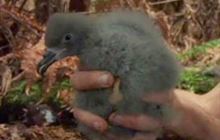Chatham Island tāiko
Introduction
The tāiko is one of the world's rarest seabirds, and nest in long burrows under forest cover.New Zealand status: Endemic
Conservation status: Nationally Critical
Population: Fewer than 200
Found in: Chatham islands
Threats: Predation, habitat loss, human disturbance
Species information: Tāiko on NZ Birds Online
Did you know?
Tāiko breed in underground burrows up to 5 m in length.
Chatham Island tāiko conservation
The tāiko is among New Zealand’s most endangered species. It's considered to be on the brink of extinction, with about only 15 known breeding pairs.
The tāiko was believed to be extinct for almost a century, until its rediscovery by David Crockett in 1978. In 1987, the first tāiko burrow was found in southern Chatham Island.
Historically, the loss of forest habitat as well as the harvesting of the birds for food are likely to have contributed to the decline of tāiko. The main cause of decline is likely to be the arrival of mammalian predators (cats, pigs, and rodents), and the introduction of weka.
Adult and fledging tāiko on the forest floor are vulnerable to cats. Burrows are too long for cats to enter, but not for rats – while adult birds are out at sea foraging, rats enter burrows and kill young unattended chicks.
Trampling of burrows by domestic and feral stock is another threat, and feral pigs have been known to dig up burrows.
Chatham Island Tāiko Recovery Plan (PDF, 140K)
Predator control
The control of predators in taiko breeding areas is the most critical work. Each year DOC runs major cat and rat control programmes in the Tuku Nature Reserve. Without rat control very few chicks survive their first few weeks.
Pairing and translocations
Tāiko burrows are monitored throughout the season to ensure chick survival. Pairings are sometimes created by introducing single prospecting birds to single birds in established burrows.
A predator-proof fence has been built around a small area of covenanted land by the Chatham Island Tāiko Trust. Since 2006 around 60 taiko chicks have been translocated there in an effort to create a new colony in this secure site. A sound system playing taiko calls lures adult taiko in to inspect artificial burrows. By 2012 fourteen of the transferred birds had returned to the Chatham's and a good proportion of those had returned to the new site.
Locating burrows
Taiko burrows are very difficult to locate as they are scattered throughout 2,500 hectares of rugged forest. Ground searches using dogs can help locate new taiko burrows in known tāiko areas. However to find taiko sites the most successful tool has been catching birds using spotlights, attaching a transmitter and then tracking them to burrows. A light aircraft is used to search the forest as the deep burrows block signals and hinder search efforts on the ground.
You can help
Support the Chatham Island Tāiko Trust to help us with tāiko conservation management techniques including:
- Radio telemetry: to catch and track adult birds and follow them to their burrows. This helps to target predator control work in these areas.
- Trained dog searches: to find burrows for monitoring and predator control.
- Electronic monitoring equipment: to monitor burrows for activity and breeding.
If you are travelling to the Chatham Islands, or transporting goods or livestock there, be careful that you don't introduce pest animals and plants or diseases. These could threaten the flora and fauna in this unique environment.
Emergency hotline
Call 0800 DOC HOT (0800 362 468) immediately if you see anyone catching, harming or killing native wildlife.
On your property
- Trap predators on your property.
- Be a responsible cat owner.
In your community
- Find and volunteer with your local community group
- Trap predators in your community
- Get kids or schools involved
See Predator Free 2050 Trust - get involved for information.
Visiting parks, beaches, rivers, and lakes
- Leave nesting birds alone.
- Use available access ways to get to the beach.
- Avoid leaving old fishing lines in the water.
- Follow the water care code and local navigation bylaws.
- Do not drive on riverbeds, or keep to formed tracks if you have to.
- Check for pests if visiting pest-free islands.
With your dog
- Only take dogs to areas that allow them, and keep them under control.
- If you come across wildlife put your dog on a lead and lead it away.
- Warn other dog owners at the location.
- Notify DOC if you see wildlife being harassed by people or dogs.
- Get your dog trained in avian awareness.
- Learn about the Lead the Way programme which encourages dog owners to become wildlife wise and know how to act to protect coastal wildlife.
Specific ways to keep wildlife safe while with your dog on beaches.





